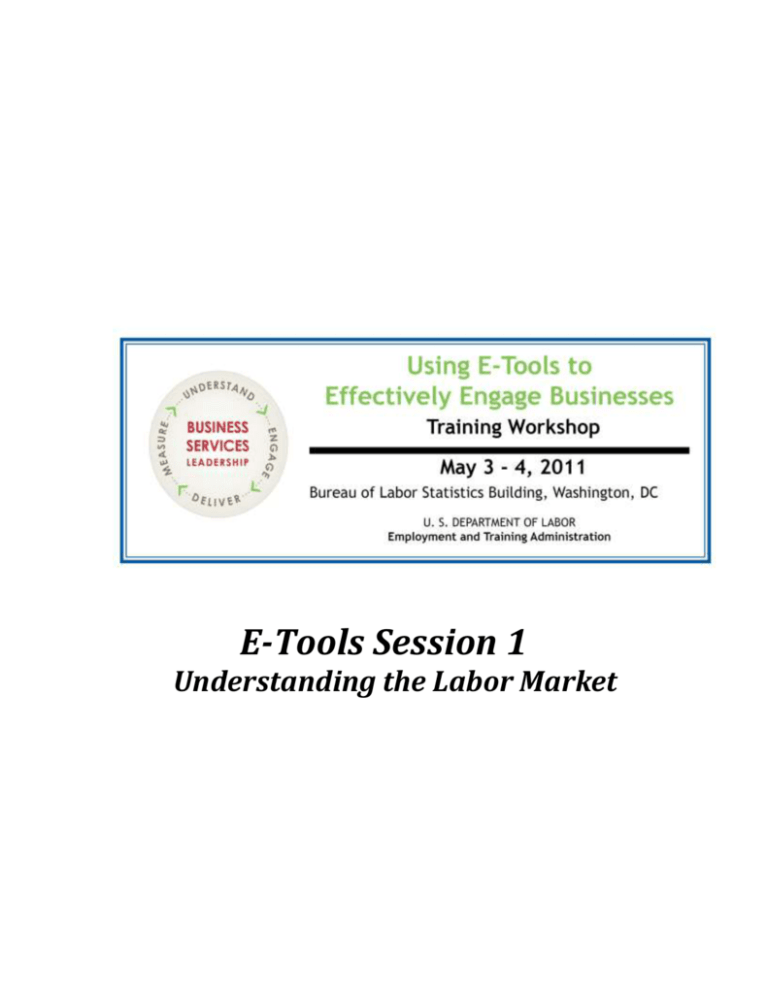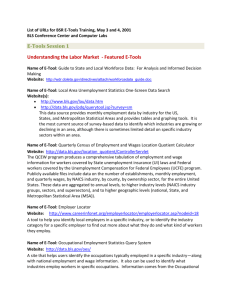E-Tools Session 1: Understanding the Labor Market
advertisement

E-Tools Session 1 Understanding the Labor Market E-Tools Session 1 Understanding the Labor Market This e-tools session will focus on the programs and websites that will help you: 1. 2. 3. 4. Find current LMI information Read LMI numbers Interpret LMI Use LMI to: a. Target businesses and industries b. Help businesses, such as providing salary information or other useful data Presenters Pam Frugoli, OWI, ETA Jennifer Troke, OWI, ETA E-Tools Covered in this Session: 1. Local Area Unemployment Statistics (5 minutes) 2. Quarterly Census of Employment and Wages Location Quotient Calculator (10 minutes) 3. Employer Locator (10 minutes) 4. Occupational Employment Statistics Query System (12 minutes) 5. My Next Move (3 minutes) 6. O*NET OnLine (3 minutes) 7. mySkills myFuture (2 minutes) E-tool 1: Local Area Unemployment Statistics One-Screen Data Search Web Address: http://data.bls.gov/pdq/querytool.jsp?survey=sm Description: This data source provides monthly employment data by industry for the US, States, and Metropolitan Statistical Areas and provides tables and graphing tools. It is the most current source of survey-based data to identify which industries are growing or declining in an area, although there is sometimes limited detail on specific industry sectors within an area. Notes: E-Tool 2: Quarterly Census of Employment and Wages Location Quotient Calculator Web Address: http://data.bls.gov/location_quotient/ControllerServlet Description: The QCEW program produces a comprehensive tabulation of employment and wage information for workers covered by State unemployment insurance (UI) laws and Federal workers covered by the Unemployment Compensation for Federal Employees (UCFE) program. Publicly available files include data on the number of establishments, monthly employment, and quarterly wages, by NAICS industry, by county, by ownership sector, for the entire United States. These data are aggregated to annual levels, to higher industry levels (NAICS industry groups, sectors, and supersectors), and to higher geographic levels (national, State, and Metropolitan Statistical Area (MSA)). The Location Quotient Calculator uses QCEW data to calculate ratios that compare the concentration of an industry in a specific area in comparison to the U.S. or other areas. Notes: E-Tool 3: Employer Locator Web site: http://www.careerinfonet.org/employerlocator/employerlocator.asp?nodeid= 18 Description: A tool to help you identify local employers in a specific industry, or to identify the industry category for a specific employer to find out more about what they do and what kind of workers they employ. Notes: E-Tool 4: Occupational Employment Statistics Query System Web site: http://data.bls.gov/oes/ Description: A site that helps users identify the occupations typically employed in a specific industry—along with national employment and wage information. It also can be used to identify what industries employ workers in specific occupations. Information comes from the Occupational Employment Statistics survey of business establishments that produces annual occupational employment and wage data for the U.S., states, and metropolitan statistical areas. Notes: E-Tool 5: My Next Move Web site: http://www.MyNextMove.gov Description: An easy to navigate, easy to understand career exploration tool based on O*NET occupational competency profiles. Notes: E-Tool 6: O*NET OnLine Web site: http://www.onetonline.org Description: A career exploration tool that offers a variety of search options to find detailed information on occupational competencies including tasks, knowledge, skills, abilities, tools and technology, and other characteristics, with links to employment and wage data. Notes: E-Tool 7: mySkills myFuture Web site: http://www.mySkillsmyFuture.org Description: A transferable skills tool for dislocated workers to help them: 1) identify other occupations where they can apply their skills, 2) identify potential skill gaps and relevant training from their current skill set and a new occupation, and 3) identify local job openings in the new career field. Notes: Questions Labor Market Information Can Answer 1. What economic sector(s) in my area are significant or has(have) grown in employment recently? (As opposed to projected to grow) TIP: Use the Local Area Unemployment Statistics One-Screen Data Search to identify industries Use the Location Quotient tool to identify significant industry sectors by state and county 2. What local firms in my county are in that critical or growing industry? TIP: Use the Employer Locator in CareerOneStop to identify 3 employers in your community 3. What occupations do firms in that industry typically employ? TIP: Use OES staffing patterns to identify key occupations 4. What skills will these occupations require? TIP: Use My Next Move to identify specific skills Use O*NET Online to get more detail about specific occupations 5. Where else might the skill sets of those occupation(s) be used? TIP: Use mySkills myFuture to identify transferable skills across occupations






